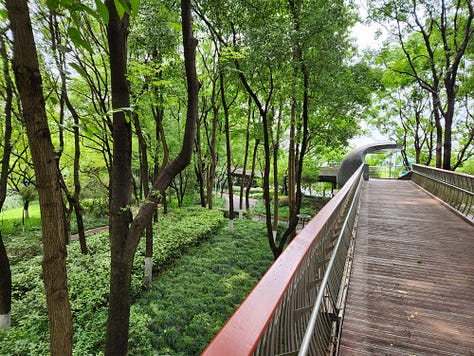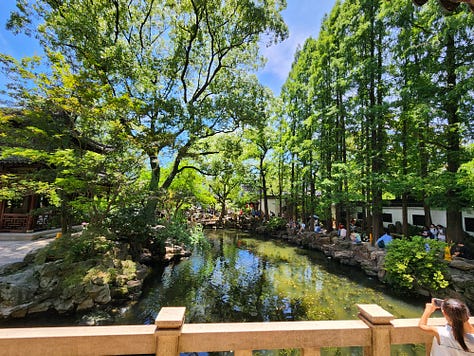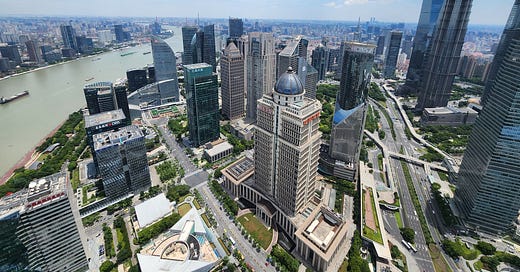Is Shanghai 20 years in the Future?
Well hello there,
I recently visited China and wanted to share some insights from the trip. But first, a note on the lack of newsletters recently.
There was a magical time in early 2024 when the Green Urbanist Weekly newsletter lived up to its name and newsletters were indeed released on a regular basis. Since March, a mix of busyness, deadlines, travel and a dose of burnout meant that I had to step away from the the newsletter and podcast. Thanks for bearing with me and I want to say a big hello to all the new subscribers who joined since March and have not received anything yet! (You can always look back at previous articles here).
I’ve got some big life changes coming, including moving to a new country at the end of August and stepping away from stable employment into the wild world of the entrepreneur/freelancer. But more on that in due course.
I am committed to sharing newsletters more often but, knowing myself, a weekly schedule may still be a challenge. If the title of this newsletter changes to ‘Green Urbanist Sporadicly’, you’ll know why.
For now, here are some reflections from my recent trip to China. I’d love to hear from you - did you find this interesting or useful? Anything to add? Click comment below or reply to the email.
Shanghai feels SciFi
The first stop on my 3-city tour of China was the financial capital, Shanghai. The city has grown from an agricultural village to a major trading port, a centre for colonial powers in China and now a global megacity of 30 million people. Walking along the city’s waterfront on a summer’s evening feels like a scene from a SciFi film, with an incredible lights show on the skyscrapers and illuminated boat tours cruising along the Huangpo river (see video below).
But it’s not just the skyline that feels futuristic. The share of electric vehicles in Shanghai is well above that of European or North American cities. At times it felt like most of the cars on the road were electric. In fact, the city hosts 1.3 million electric and hybrid vehicles, representing almost 30% of the city’s 4.5 million cars. For reference, even the best performing parts of London have less than half this level of ownership. The result is that even multi-lane streets with lots of traffic were surprisingly quiet - an often overlooked benefit of transitioning away from combustion engine vehicles.
There are lots of reasons for this China’s rapid adoption of ‘new energy vehicles’, and this article from Harvard Business Review explains a few. Here’s an incredible statistic: China is responsible for 60% of global electric vehicle sales. This is one of the most tangible reasons that Shanghai in particular feels decades ahead of London and other major European cities in terms of sustainability.
As exciting as this is, there are still lots of reasons to not love electric vehicles. They still cause traffic and fatal collisions. Roads and parking infrastructure gobbles up space that could be used for ecology, recreation spaces and homes. The EV industry is also linked to human rights issues in their supply chains and pollution in their production. Reducing vehicle ownership and usage overall remains an essential climate response alongside the transition to zero emission technology.
In this regard, I was even more impressed by the high speed rail system in China and the metro systems in all the cities I visited. Below is a map of Shanghai’s metro system, showing how incredibly comprehensive it is. The first line opened in 1993 and new lines have been added annually since then. This also means that stations and trains are generally all modern, comfortable, clean and air conditioned - a stark contrast to many London Underground lines, which date back to the Victorian era.
But surprisingly green
The view from the plane as I landed in Shanghai’s international airport gave the impression of a grey, high-rise, Blade Runner-esque cityscape. As I walked the streets I was surprised to find how green the city was. Maturing trees line many streets, where huge crickets make an incredible racket. Green corridors have been created along rivers and some roads. The public space and landscape design is often genuinely world class. Climbing plants wind their way up the enormous concrete legs of highway infrastructure, lending an almost post-apocalyptic feel to some street scenes (side note: it says a lot about our culture that allowing nature to flourish in cities makes us feel that something awful must have happened). The green illusion is unfortunately ruined by the many huge roads that bisect the city (okay, last complaint about cars for now).



I had to remind myself that Shanghai has a humid subtropical climate, with perfect conditions for vibrant vegetation growth (warm and wet). It’s hard to compare with the UK or Europe, which are generally cooler and drier. But we can still take inspiration.
There are so many more insights and interesting tidbits I took away from my trip. But these will have to wait for an upcoming podcast episode. Stay tuned!
p.s. China has a complex and bloody history and nothing in this newsletter should be interpreted as a positive sentiment towards an authoritarian regime. I’m not the right person to analyse how this has influenced their urbanism except that if you are a one-party state with an enormous economic base, it’s probably pretty easy to do big infrastructure projects!
p.p.s. If you want to visit China, be smarter than me and don’t go in July. It is unbelievably hot and humid!
Till next time,
Ross O’Ceallaigh






